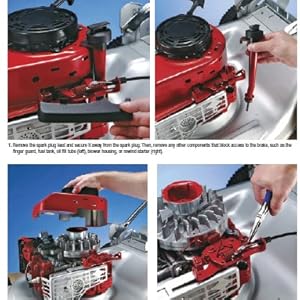Small Engines and Outdoor Power Equipment, Updated 2nd Edition: A Care & Repair Guide for: Lawn Mowers, Snowblowers & Small Gas-Powered Imple
$16.14

Price: $16.14
(as of Apr 01,2022 03:29:32 UTC – Details)
From the Publisher


Introduction
Unless you’re among the small but enthusiastic group of “motorheads” who collect, troubleshoot, and restore vintage lawn mowers, chain saws, garden tractors, snowblowers, or old outboard motors as a hobby, you probably opened this book because some small engine in your life just isn’t running right. Maybe it’s hard to start or sometimes doesn’t start at all. Perhaps your small engine runs, butsounds strange; like it’s got real problems somewhere deep down inside. Quite possibly you’re wishing you had the mechanical equivalent of a “green thumb” so you could save money on small-engine repairs. With most power equipment shops charging hourly repair rates comparable to those of a luxury car dealership’s service department, it is no wonder why many folks who don’t consider themselves particularly handy get so darn frustrated by their persnickety weed-whacker or messed-up mower that they feel there’s no alternative but to buy a new one.






THINGS THAT MAKE A SMALL ENGINE RUN
The biggest difference between small gasoline engines and other types of fuel burning motors is their small capacity and simplicity of design. Small engines generate modest amounts of power—generally 2 to 25 horsepower—compared to a typical family car boasting 150 or more horses. And a small engine’s compact size also makes it easier to maintain and repair.
DIAGNOSING & TROUBLESHOOTING
Troubleshooting always begins with diagnosis. In this chapter, you’ll find lists of common problems followed by questions and then potential answers, along with references to the appropriate section in the book where the potential solution is discussed in detail and the steps for making the necessary repair are shown. It’s not always an exact science, but it is the basic procedure for fixing just about anything. And if all else fails, have you tried rebooting?
EASY BUT IMPORTANT MAINTENANCE
You often hear people lament that we now live in such a throwaway society. There is, of course, much truth in this complaint. Whether it is an electronic device or a pair of shoes, the trouble and cost of repairing a problem very frequently exceeds the cost of replacing them. And in many cases, access to the moving parts is practically impossible with little prospect of ever getting the thing put back together. However, tools and appliances that run on small gas engines can usually be kept out of the landfills and recycling centers for years, or decades, simply by following a simple maintenance program, and perhaps making some occasional repairs when they are called for. Eventually their day will come, of course, or your needs may change, or perhaps you’ll simply succumb to the appeal of a shiny new lawn tractor or the latest snowblower. But in the meantime, follow the easy but important maintenance tips in this chapter and you will greatly extend the lifespan of your gas-powered too.






BASIC ENGINE REPAIRS
Many of the most common small-engine repairs are actually quite easy to accomplish provided you know what you are doing and get the right parts. A “basic” repair often comes down to making a simple adjustment or cleaning a part. The primary components of the fuel system are mostly easy to diagnose and adjust or re-adjust. These include the fuel tank, fuel filter, and fuel pump. The exhaust system also avails itself to fairly simple repairs, such as swapping out a muffler. Other repairs covered in this “basic” chapter get a little more complex, such as servicing a carburetor or replacing a rewind. But, again, with patience and good information (and the right parts) they are very manageable, even for a weekend DIYer with little mechanical experience.
ADVANCED REPAIRS
The systems and techniques in this section are more complex than those described in the Basic Repair section, but they’re well within your reach now that you have some primary repair projects in your repertoire, as the same basic principles apply. If an advanced repair task is new to you, start by reviewing “Trouble-shooting” (pages 36 to 41) and “Safety” (pages 32 to 33).
2-STROKE POWER EQUIPMENT
In a 2-stroke engine, the piston acts as a valve, exposing the intake and exhaust ports at designated moments in the cycle. Two-stroke engines are still widely used for chain saws, leaf blowers, and other hand held equipment. They are also common for outboard motors and motocross motorcycles. They are no longer used on street bikes in many countries because of older 2-stroke engines’ higher emissions. Two-stroke engines have long been preferred for hand-held equipment because of their lightweight design. However, the latest technology has reduced the weight of 4-stroke engine components, creating the potential for inroads in the hand-held equipment industry.
Publisher : Cool Springs Press; Illustrated edition (September 28, 2020)
Language : English
Paperback : 144 pages
ISBN-10 : 0760368783
ISBN-13 : 978-0760368787
Item Weight : 1.35 pounds
Dimensions : 8.8 x 0.55 x 11.2 inches

$16.14







